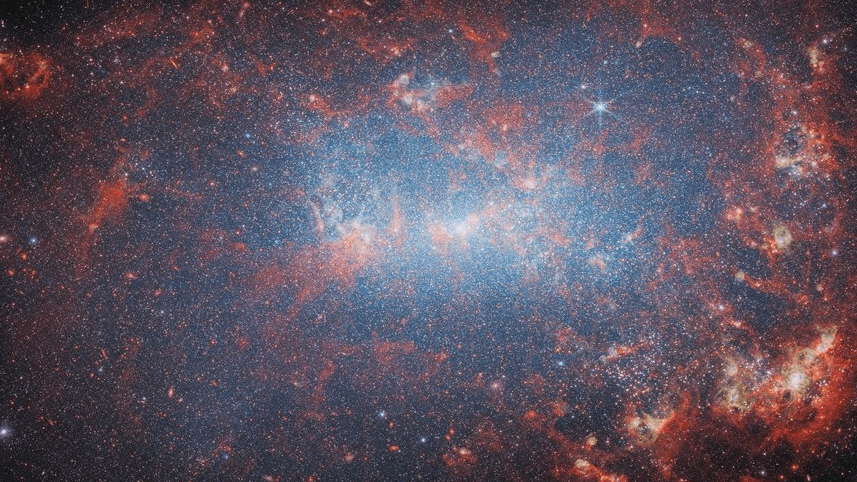Dwarf galaxy NGC 4449 is the star of the show The James Webb Space Telescopehis latest cosmic portrait.
Located 12.5 million light-years away in the constellation of Canes Venatici, the Hunting Dogs, NGC 4449 has a lot in common with our own. Large Magellanic Cloud (LMC), orbiting satellite galaxy Milky Way. Both are small and irregular in shape and each has a distinct band running through its center. However, while the LMC has an extreme region of star formation, which is the 30 Doradus region known famously as the Tarantula. NebulaNGC 4449 has been upgraded STAR– the formation of norms in its length and breadth. Indeed, there is so much star formation going on that NGC 4449 is described as undergoing a “starburst”.
Connected: The James Webb Space Telescope discovers the most distant and oldest black hole collision ever seen
Starbursts occur when the molecular hydrogen gas filling a galaxy is driven by a gravitational interaction or a collision with another galaxy. NGC 4449 is part of the M94 Group of about two dozen galaxies, so it has several neighbors it could interact with.
Indeed, in 2012. a professional-amateur collaboration led by David Martinez-Delgado of the Max Planck Institute for Astronomy in Germany and featuring the work of several outstanding amateur astrophotographers as well as observations from the eight-meter Subaru telescope on Mauna Kea in Hawaii, found evidence for such an interaction. The team resolved a stream of stars ejected from a smaller galaxy that had experienced its infall by being consumed by NGC 4449.
Although the small galaxy was torn apart by the larger NGC 4449, it has not gone quietly. Gravitational tidal forces resulting from being so close to NGC 4449 have created turbulence in the molecular gas across NGC 4449, causing large pockets to gravitationally collapse and form numerous clusters of young stars. These star clusters, among other features, are visible in JWST’s latest image, constructed with a combination of data from its Near Infrared Camera (NIRCam) and Mid-Infrared Instrument (MIRI ). Operating at different infrared wavelengths (0.6 micron to 5 micron and 5 micron to 28 micron, respectively), they detect different types of features in the galaxy.
The near-infrared view of NGC 4449 looks fundamentally different from the mid-infrared view. It is important to note that all colors are false colors that stand for infrared wavelengths.

NIRCam shows a visible star bar that is filled with clusters of hot newborn stars, amid a background of older stars whose combined light appears as a diffuse blue glow. Dusty trails surround the bright center, marking star-forming regions of molecular gas ionized by radiation from the cluster’s resident newborn stars. These clusters are represented by compact blue regions embedded in the gas.
The MIRI image captures the dusty skeleton of NGC 4449, which traces the bar, but also appears more concentrated around that bar than the material visible to NIRCam.

Inside the dust, indicated by a red-orange color, are polycyclic aromatic hydrocarbons, known for short as PAHs. These carbon-based molecules are the building blocks of interstellar dust grains and play a key role in cosmic chemistry and the spread of organic material throughout the galaxy. The bright yellow areas are sites of active star formation, and the bright blue spots signal a host of gaseous stellar bodies in the galaxy.
Combined, the NIRCam and MIRI data present a remarkable picture of a galaxy undergoing a turbulent phase that will shape it for billions of years to come.

NGC 4449 is a preview of what may one day happen in the LMC, if its interactions with its sibling, Small Magellanic Cloud, or even our own Milky Way, become very large. NGC 4449 is also a modern version of the small galaxies that JWST is also finding existed in the early universe. Those early dwarf galaxies were the building blocks of the larger galaxies we see today, and through their starbursts, contributed to a a significant fraction of the ionization energy required to bring cosmic dark ages to an end. As such, NGC 4449 is a unique window into both the past and future of galactic evolution.
